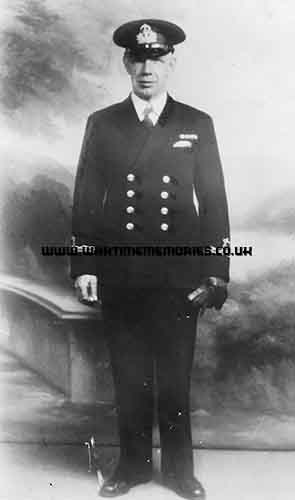In September 1939 the passenger ship Montrose, owned by Canadian Pacific Steamships Ltd of Montreal, was requisitioned by the British Admiralty and converted to the armed merchant cruiser HMS Forfar. Conversion was completed on 6 November 1939.
On 2 December 1940 HMS Forfar, with Captain Norman Arthur Cyril Hardy RN in command, was attacked by the German submarine U-99. She was outward bound - via convoy - from Liverpool to the United States - about 500 nautical miles west of Ireland.
At 05.46 hours on 2 Dec 1940, the Forfar was hit by one torpedo from U-99, commanded by U-boat ace Otto Kretschmer. She finally sank at 06.57 hours, after four additional torpedo hits at 06.39, 06.43, 06.50 and 06.57 hours. The master, 35 officers and 136 naval ratings were lost. Three officers and 18 naval ratings were rescued by HMCS St Laurent, HMS Viscount and the British merchant ship Dunsley, and they were landed at Oban in Scotland.
At 16,402 tons, the Forfar is believed to have been one of the largest ships to be sunk by U-boats in the Second World War.
Among those of the crew who were lost was 52-year-old warrant officer David Jones.
Born in Birkenhead, David was the son of John and Minnie Jones and the brother of Elizabeth Humphreys (nee Jones). In the early war years Britain desperately needed fast convoy escorts but lacked the number of warships to fulfill this role. Several ocean liners were "taken up from trade" by the Royal Navy to act as Armed Merchant Cruisers (AMCs) after having basic armament fitted. As these ships already had experienced crews the merchant seamen were simply asked to sign an agreement to serve alongside the Royal Navy in naval uniform as Naval Auxiliary Personnel (NAP) and be subject to naval discipline. David was a NAP, and a carpenter by trade.
David married Isabella Shannon in Liverpool in 1918 and the couple had three daughters: Muriel, Eileen and Catherine. His brother-in-law Charles Long - who had volunteered to join the Merchant Navy on the outbreak of the war - was due to sail with David on HMS Forfar. But at the last moment Charles was rejected on medical grounds (a hernia) and escaped his brother-in-law's fate.
Otto Kretschmer is regarded as the most successful German U-boat commander in the Second World War. From September 1939 until being captured in March 1941, he sank 47 ships, a total of 274,333 tons. For this he received the Knight's Cross of the Iron Cross with Oak Leaves and Swords, among other awards. He earned the nickname "Silent Otto" both for his successful use of the "silent running" capability of U-boats as well as for his reluctance to transmit radio messages during patrols. After the war, he served in the German Federal Navy and retired in 1970 with the rank of Flottillenadmiral (flotilla admiral, equivalent to a Royal Navy Commodore).




